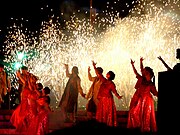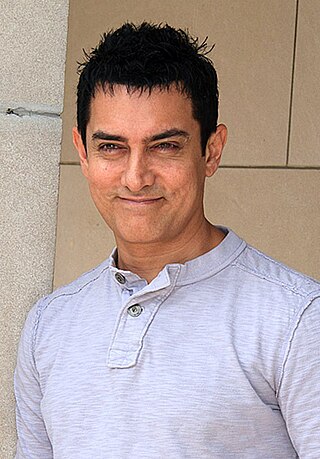Portal:Hindi cinema
The Hindi cinema portal

Hindi cinema, popularly known as Bollywood and formerly as Bombay cinema, refers to the film industry based in Mumbai, engaged in production of motion pictures in Hindi language. The popular term Bollywood is a portmanteau of "Bombay" (former name of Mumbai) and "Hollywood". The industry is a part of the larger Indian cinema, which also includes South Indian cinema and other smaller film industries.
In 2017, Indian cinema produced 1,986 feature films, of which the largest number, 364 have been in Hindi. , Hindi cinema represented 43 percent of Indian net box-office revenue; Tamil and Telugu cinema represented 36 percent, and the remaining regional cinema constituted 21 percent. Hindi cinema is one of the largest centres for film production in the world. Hindi films sold an estimated 341 million tickets in India in 2019. Earlier Hindi films tended to use vernacular Hindustani, mutually intelligible by speakers of either Hindi or Urdu, while modern Hindi productions increasingly incorporate elements of Hinglish.
The most popular commercial genre in Hindi cinema since the 1970s has been the masala film, which freely mixes different genres including action, comedy, romance, drama and melodrama along with musical numbers. Masala films generally fall under the musical film genre, of which Indian cinema has been the largest producer since the 1960s when it exceeded the American film industry's total musical output after musical films declined in the West. Dadasaheb Phalke's silent film Raja Harishchandra (1913) is the first feature length film made in India. The first Indian musical talkie was Alam Ara (1931), four years after the first Hollywood sound film The Jazz Singer (1927).
Alongside commercial masala films, a distinctive genre of art films known as parallel cinema has also existed, presenting realistic content and avoidance of musical numbers. In more recent years, the distinction between commercial masala and parallel cinema has been gradually blurring, with an increasing number of mainstream films adopting the conventions which were once strictly associated with parallel cinema. (Full article...)
Selected article
Mr. and Mrs. Iyer is a 2002 Indian drama film written and directed by Aparna Sen and produced by N. Venkatesan. The film features Aparna Sen's daughter Konkona Sen Sharma as Meenakshi Iyer, a Tamil Iyer Brahmin who is Hindu. Rahul Bose portrays the character of Raja Chowdhury, a Bengali Muslim wildlife photographer. The story revolves around these two lead characters during a fateful bus journey amidst the carnage of communal strife in India. Zakir Hussain, an Indian tabla maestro, composed the background score and music for the film; Goutam Ghose, a film director himself, was the cinematographer. Mr. and Mrs. Iyer premiered at the Locarno International Film Festival in Switzerland and was showcased at other prominent film festivals. The film opened to Indian audiences on 19 July 2002. It was met with critical acclaim upon release, and won several national and international awards, including the Golden Maile award at the Hawaii International Film Festival and the Nargis Dutt Award for Best Feature Film on National Integration in India. The film, which was also released on DVD, used English as its predominant language, with sporadic Hindi, Tamil, and Bengali.
Did you know...
- ... that the film English Vinglish marks the comeback of actress Sridevi (pictured) after a 14-year sabbatical?
- ... that Vyjayanthimala, who played Chandramukhi in the 1955 film Devdas, declined the Filmfare Award for Best Supporting Actress because she thought that her role was not a supporting one?
- ... that Master Vithal, the hero of India's first talkie Alam Ara and many silent stunt films, was known as the "Douglas Fairbanks of India"?
Subcategories
Selected biography
Preity Zinta (born 31 January 1975) is an Indian film actress. She has appeared in Hindi- , Telugu-, Punjabi- and English-language films. After graduating with a degree in criminal psychology, Zinta made her acting debut in Dil Se.. in 1998, followed by a role in Soldier the same year. These performances earned her a Filmfare Award for Best Female Debut, and she was later recognised for her role as a teenage single mother in Kya Kehna (2000). She subsequently played a variety of character types; her film roles, along with her screen persona, contributed to a change in the concept of a Hindi film heroine. Zinta received a Filmfare Award for Best Actress in 2003 for her performance in the drama Kal Ho Naa Ho. She went on to play the lead female role in two consecutive annual top-grossing films in India: the science fiction film Koi... Mil Gaya (2003), her biggest commercial success, and the star-crossed romance Veer-Zaara (2004), which earned her critical acclaim. Her first international film role was in the Canadian film Heaven on Earth, for which she was awarded the Silver Hugo Award for Best Actress at the 2008 Chicago International Film Festival.
Selected image
WikiProjects
Recognised content
Topics
Awards: Bollywood Movie Awards (defunct) • Filmfare Awards • Global Indian Film Awards (defunct) • International Indian Film Academy Awards • National Film Awards • Screen Awards • Star Guild Awards • Stardust Awards • Zee Cine Awards
Institutions Asian Academy of Film & Television • Central Board of Film Certification • Directorate of Film Festivals • Film and Television Institute of India • Film City • Fox Star Studios • National Film Development Corporation of India • Satyajit Ray Film and Television Institute
Lists: List of Bollywood films • Film clans • Highest-grossing films in overseas markets • Highest-grossing films
Things you can do
- Add
{{portal|Hindi cinema}}to the See also section of Bollywood film-related articles. - Tag the talk pages of Bollywood film related articles with the {{WikiProject Film|Indian-task-force=yes}} banner.
- Collaborate with other participants at Wikipedia:WikiProject Film/Indian cinema task force.
- Cleanup: A cleanup listing for this project is available.
- Rate the Unassessed Bollywood articles in the Indian cinema task force.
- Cleanup needed
- Bot-generated cleanup listing • Hindi films and plagiarism • Ramoji Film City • IIFA Awards • IIFA • Anand Bakshi • Ajay Devgan • N. T. Rama Rao Jr.
- Requested articles
- List of missing Indian Films (see also lists of Indian films for redlinks) • Beary Cinema
- Expansion needed
- Draft articles: Tulu cinema • Anahat (film) • Prakash Jha • Central Board of Film Certification • Filmfare Awards South • Kerala Film Critics Association Awards • Amitabh Bachchan • Gabbar Singh • Sanjay Dutt • Hindustan Photo Films • Sanskrit cinema
- Citations needed
- Central Board of Film Certification
Related portals
Associated Wikimedia
The following Wikimedia Foundation sister projects provide more on this subject:
-
Commons
Free media repository -
Wikibooks
Free textbooks and manuals -
Wikidata
Free knowledge base -
Wikinews
Free-content news -
Wikiquote
Collection of quotations -
Wikisource
Free-content library -
Wikiversity
Free learning tools -
Wiktionary
Dictionary and thesaurus
























